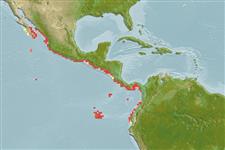Environment: milieu / climate zone / depth range / distribution range
Sinh thái học
Biển Cùng sống ở rạn san hô. Tropical; 26°N - 3°S, 113°W - 76°W (Ref. 114953)
Eastern Central Pacfic: Baja California (Mexico) to Ecuador; including the Galapagos Is.
Length at first maturity / Bộ gần gũi / Khối lượng (Trọng lượng) / Age
Maturity: Lm 110.0 range ? - ? cm
Max length : 260 cm TL con đực/không giới tính; (Ref. 9254)
Inhabit rocky and coral reefs (Ref. 12951); on soft and sandy bottoms. Feeds mainly on mantis shrimps and fishes (Ref. 114953). Ovoviviparous (Ref. 50449). Litters of 1-5 pups; gestation period 10-11 months (Ref. 114953); Caught rarely by the gillnet fisheries operating in shelf waters. Utilized for its meat (Ref.58048).
Exhibit ovoviparity (aplacental viviparity), with embryos feeding initially on yolk, then receiving additional nourishment from the mother by indirect absorption of uterine fluid enriched with mucus, fat or protein through specialised structures (Ref. 50449). Distinct pairing with embrace (Ref. 205). Brood consists of 1-3 neonates and grow to about 40 cm DW in spring-summer (Ref. 38396).
Compagno, L.J.V., 1999. Checklist of living elasmobranchs. p. 471-498. In W.C. Hamlett (ed.) Sharks, skates, and rays: the biology of elasmobranch fishes. Johns Hopkins University Press, Maryland. (Ref. 35766)
IUCN Red List Status (Ref. 130435: Version 2024-1)
Human uses
Các nghề cá: buôn bán nhỏ
Các công cụ
Special reports
Download XML
Các nguồn internet
Estimates based on models
Preferred temperature (Ref.
123201): 23.1 - 28.5, mean 27 °C (based on 40 cells).
Phylogenetic diversity index (Ref.
82804): PD
50 = 0.5039 [Uniqueness, from 0.5 = low to 2.0 = high].
Bayesian length-weight: a=0.00468 (0.00195 - 0.01123), b=3.12 (2.92 - 3.32), in cm total length, based on LWR estimates for this (Sub)family-body shape (Ref.
93245).
Mức dinh dưỡng (Ref.
69278): 3.5 ±0.37 se; based on food items.
Thích nghi nhanh (Ref.
120179): Rất thấp, thời gian nhân đôi của chủng quần tối thiểu là hơn 14 năm (Fec=1-3).
Fishing Vulnerability (Ref.
59153): Very high vulnerability (90 of 100).
Nutrients (Ref.
124155): Calcium = 4.25 [0.50, 62.97] mg/100g; Iron = 0.352 [0.028, 3.714] mg/100g; Protein = 22.4 [20.0, 24.7] %; Omega3 = 0.0681 [, ] g/100g; Selenium = 41.8 [8.1, 218.8] μg/100g; VitaminA = 14.9 [1.2, 155.3] μg/100g; Zinc = 0.592 [0.036, 6.796] mg/100g (wet weight);
